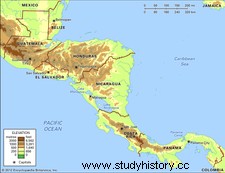United Provinces of Central America , Spanish Provinces Unidas De Centro-américa (1823–40), Union of modern-day states Guatemala , Honduras , El Salvador , Costa Rica and Nicaragua .
 Read more about this topic Central America:The United Provinces (1823–40) A Liberal-dominated assembly elected from all provinces convened in Guatemala that declared independence from . ..
Read more about this topic Central America:The United Provinces (1823–40) A Liberal-dominated assembly elected from all provinces convened in Guatemala that declared independence from . .. Since the 1520s, these regions, along with the state of Mexico, had Chiapas formed the Captain General of Guatemala, who was part of the Viceroyalty of New Spain ( Mexico ). In 1821 they became independent from Spain and in 1822 they became part of the ephemeral Empire of Mexico under the rule of Agustín de Iturbide attached . After Iturbide's abdication in March 1823, delegates from the Central American provinces what mostly the Upper class Creoles, in Guatemala - City assembled in July to declare to become fully independent and a federal formation United Provinces by Central America . They created a Constitution which has a federal capital in Guatemala City and a president for each of the five Voter intended States that should enjoy full local autonomy; Suffrage was limited to the upper classes, slavery was abolished, and the privileges of the Roman Catholic Church were preserved. Manuel José Arce was elected the first president in 1825.
Liberal-conservative disagreements developed and soon erupted into civil war; The Liberals gained control as their leader in 1830, Francisco Morazán was elected President. His administration quickly dissolved the church and passed a series of anticlerical laws; Additional measures to promote trade and industry have been taken. In 1834, Morazán moved the capital of the Founding Confederation from Guatemala City, a conservative stronghold, after San Salvador .
After an outbreak of cholera in 1837, the Clergy accused the "godless" liberals, donated the Conservative an Indian uprising. A mestizo rebel leader, Rafael Carrera captured Guatemala City in 1838, after which most member states went their own way. Up to April 1839 only El Salvador remained faithful. Morazán resigned after a disastrous defeat at the hands of Carrera in March 1840.
Approximately 25 failed attempts were made to restore the union. During the 19th century, the Guatemalan government tried many times to by force the Hegemony over the other Central American countries obtain . Carrera, who controlled the Guatemalan government until his death in 1865, frequently interfered in El Salvador, Honduras and Nicaragua by imposing conservative regimes. Justo Rufino Barrios , President of Guatemala from 1873 to 1885, pushed for the revival of the old federation in 1882; In 1885 he declared himself ruler and marched with his army to El Salvador, where he was defeated and killed Battle of Chalchuapa (April 2).
